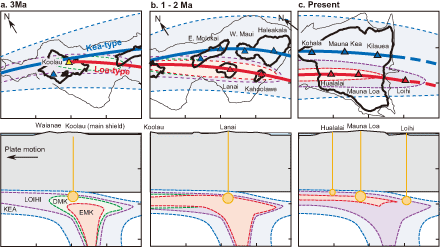Chemical structure of the Hawaiian plume
The two parallel loci of recent Hawaiian volcanoes, Kea and Loa, have been regarded as the best targets to interpret the chemical structure of an upwelling mantle plume derived from the lower mantle. Here we show that the Sr-Nd-Hf-Pb isotopic data of the shield building lavas along the Loa locus form a systematic trend from the main shield stage of Koolau (>2.9 Ma) to the active Loihi volcanoes. The abrupt appearance of Loa type magmatism should be attributed to the transient incorporation of the relatively dense recycled material and surrounding less degassed lower mantle material that accumulated near the core-mantle boundary into the upwelling plume. This episodic involvement could have been trigged by episodic thermal pulses and buoyancy increases in the plume. The continuous appearance of Kea-type lavas during the long history of Hawaiian-chain magmatism and the larger magma volume of Kea-type lavas relative to that of the Loa-type lavas in the last 3 Myr indicate that the Kea locus is closer to the thermal centre of the Hawaiian plume relative to that of the Loa locus.

References:
- Ryoji Tanaka, Akio Makishima, Eizo Nakamura. Hawaiian double volcanic chain triggered by an episodic involvement of recycled material: Constraints from temporal Sr–Nd–Hf–Pb isotopic trend of the Loa-type volcanoes, Earth and Planetary Science Letters, 265(3-4), 450-465 (2008). doi:10.1016/j.epsl.2007.10.035, dream/20100403102546814.